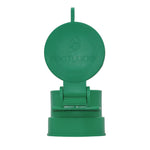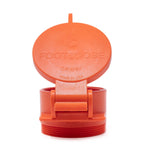You have no items in your shopping cart.
It’s easy to overlook the plumbing system in your RV. Good RV plumbing makes you feel at home on the road, with hot showers in the morning, a fully-functioning toilet, and potable water flowing in the sink. But have you ever stopped to think about how it all works? RV plumbing is an impressive display of engineering efficiency, without which RVing would be less convenient and fun.
Let’s take a look at how RV plumbing works to get a better appreciation for how one of the most important parts of your RV functions.
RV Plumbing Basics
The plumbing in your RV is very similar to the plumbing in your home. The water pump sends water on demand wherever it's needed, and the water heater keeps the hot water hot, so you don’t get any unpleasant surprises in the middle of your shower. The only difference is that the water comes from a storage tank instead of a city supply line, and used water is collected in separate holding tanks.
RV Water Tank
The RV holding tank is one of the most important parts of your RV, allowing you to bring fresh water for drinking, cooking, and washing with you wherever you go. How much water your tank holds depends on what kind of RV you have. Larger RVs usually have larger tanks, but even RVs in the same class can have a range of capacities. Typically, Class A RVs have the largest tanks, and Class Bs have the smallest, although some Class Bs don’t have any plumbing.
Average tank capacity by class:
- Class A: 75–100 gallons
- Fifth Wheel Trailers: 50–90 gallons
- Class C: 35–60 gallons
- Class B: 15–40 gallons
Many RV water tanks are kept out of the way under the chassis, which is a convenient location, although it does increase the chances of your RV water tank freezing in colder environments.
External water tanks need to be insulated to prevent them from freezing and creating a potential problem for your entire plumbing system. A frozen tank can lead to damaged pipes and valves that could cost a significant amount of time and money to fix.
Some RVs have their water storage tank above floor level. This design makes it easier for you to prevent it from freezing, as your RV’s heating system can keep it warm.
Where to Get Water
Where to fill your RV water tank should be something you plan before your trip. If you’re staying at a campground that accommodates RVs, you can fill your water tank from a dedicated hookup on your site or a central filling station. Make sure you have a food-grade hose since ordinary hoses can impart funky tastes or make you sick as they deteriorate with use.
If you’re not camping in your RV, where to get water will depend on where you’re traveling. If you’re near a metropolitan or suburban area, you can fill your RV water tank from a city source. In more rural areas, your best bet is to ask the locals where you can get potable water. Truck stops and rest areas are usually your best options.
RV Water Filter
Top-notch RV plumbing systems use water filters to ensure clean, potable water flows from your taps. RV water filters remove bacteria, mold, unpleasant odors, sediment, and harmful chemicals from your water, ensuring that your drinking water is safe to consume and doesn’t have a funny taste.
Without a water filter in your RV, you and your family could be exposed to a host of diseases like Giardia, Legionella, and E. Coli. Campground hookups, lakes, and streams may look clean, but it’s impossible to tell by eye whether the water they provide is safe to drink. If you’re traveling remotely, a water filter is essential to your RV’s plumbing system, removing doubt about your water’s quality and keeping everyone on board healthy.
RV Water Pump
A full water tank isn’t very useful without a way to disperse it, and that’s precisely what your RV’s water pump is for.
RV water pumps are controlled by a switch that primes and pressurizes the system when turned on. Once your water pump is activated, it will send water wherever needed when you open a faucet or flush the toilet.
A properly cared for water pump usually lasts up to ten years, so it’s worth learning how to maintain and winterize your RV to get the most out of it. Most RV water pumps are low-maintenance and operate hands-off with few problems.
How an RV Water Heater Works
The water heater in your RV is basically a miniaturized version of the one in your home, complete with an electric element to heat the water and a tank to store it.
You should regularly check your RV’s water heater tank for corrosion since they erode over time. The tank should have an anode designed to decay before the tank walls that you can use to gauge the wear on the tank. When the anode shows signs of significant wear, it’s time to think about replacing the tank.
Will RV Water Heater Freeze?
Freezing is not an issue for most RV water heaters since they’re usually kept inside the climate-controlled part of your RV. However, if your heating system fails or you leave it off for an extended period in extreme cold, it could freeze. It’s much less likely for an RV water heater to freeze than a standard water tank. The residual heat inside the RV will keep the water in the heater’s tank warmer much longer than the water in the external tank.

RV Waste System
The sewage system is the part of an RV’s plumbing that most people don’t want to think about. Problems with your RV’s waste management system can be unpleasant, but luckily, it’s easy to avoid issues if you know how it works.
Gray vs. Black Water
Your RV’s waste system has two separate tanks for different kinds of wastewater: gray water and black water. Understanding the difference between gray and black water is an important part of being a responsible RV owner since the two tanks have different maintenance requirements and need to be drained in different ways.
The gray water tank is where water from your shower, kitchen sink, and bathroom sink drains. It contains bacteria and is not safe to drink but can be filtered and safely used for watering your plants or flushing the toilet.
The black water tank is where human waste from your RV’s toilet is held. Black water is not safe for any use and must be drained properly into a sewer system.
How RV Toilets Work
Non-compostable RV toilets use either your fresh water or gray water and then drain into a sewage holding tank when flushed. The waste tank is often called the “wastewater tank” or the “black water tank.”
You can use your RV toilet just like an ordinary toilet, although most people recommend using less toilet paper to avoid unpleasant clogs.
Where to Dump Tanks
RV-compatible campgrounds have either a hookup on each campsite or a dedicated dumping station where you can dump your waste tank. All you need to empty your waste tank is the right RV sewer hose.
Emptying the tank is as easy as connecting one end of the hose to your RV’s sewer valve and the other to the dumping station. When you release the wastewater tank valve, your waste will flow through the hose into the sewer system.
If you’re not staying at a campground, you’ll have to do a little extra work to find out where to dump your waste. Truck stops and rest areas are your best bets again since many have RV hookups where you can dump your black water tank.
Final Thoughts
Keeping your RV’s plumbing system in good working order is essential to getting the most out of your home away from home. You don’t need to be an expert plumber to understand how your RV’s plumbing works at a high level, and a little knowledge goes a long way towards making sure time on the road is as safe and fun as possible.









